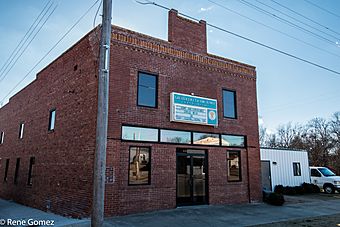Black Theater of Ardmore facts for kids
Quick facts for kids |
|
|
Black Theater of Ardmore
|
|
 |
|
| Location | Ardmore, Oklahoma |
|---|---|
| Built | 1922 |
| NRHP reference No. | 84002978 |
| Added to NRHP | June 22, 1984 |
The Black Theater of Ardmore is an important old building in Ardmore, Oklahoma, USA. It was built in 1922. This was a time when people were separated by race, which was called racial segregation. In Ardmore, over 2,000 African American people lived there. They had their own shops and homes.
The theater gave entertainment to Black residents. They were not allowed to go to theaters for white people. This building also shows how strong the Black business area in Ardmore once was. It worked as a theater until 1944. Then, it was sold to the Metropolitan African Methodist Episcopal Church. Today, the building is on the National Register of Historic Places. This means it is a special place in history.
A Place for Entertainment and Community
The Black Theater of Ardmore was more than just a place to watch movies or shows. It was a central spot for the Black community in Ardmore. During the time of segregation, Black people faced many unfair rules. They were often kept apart from white people in public places. This included schools, restaurants, and even movie theaters.
Because of these rules, Black communities often created their own spaces. The Black Theater was one of these important places. It gave people a safe and fun place to gather. They could enjoy films, music, and other performances together. It was a place where friends and families could relax and feel welcome.
Why Was It Built?
In 1922, Ardmore had a busy Black business district. This area had many shops, services, and places for people to meet. The theater was built right in the middle of this lively area. It showed how strong and active the Black community was.
The theater helped meet the needs of the community. It provided entertainment that was not available elsewhere. It also served as a symbol of pride and independence. It was a place where people could feel a sense of belonging.
Its Later Years
The Black Theater operated for over 20 years. It was a popular spot for many people. In 1944, the building changed hands. It was bought by the Metropolitan African Methodist Episcopal Church. This church continued to use the building for community gatherings.
Today, the building reminds us of an important time in history. It shows how communities created their own spaces. It also highlights the strength of people during difficult times. Being on the National Register of Historic Places means it is protected. It helps us remember its special story.



